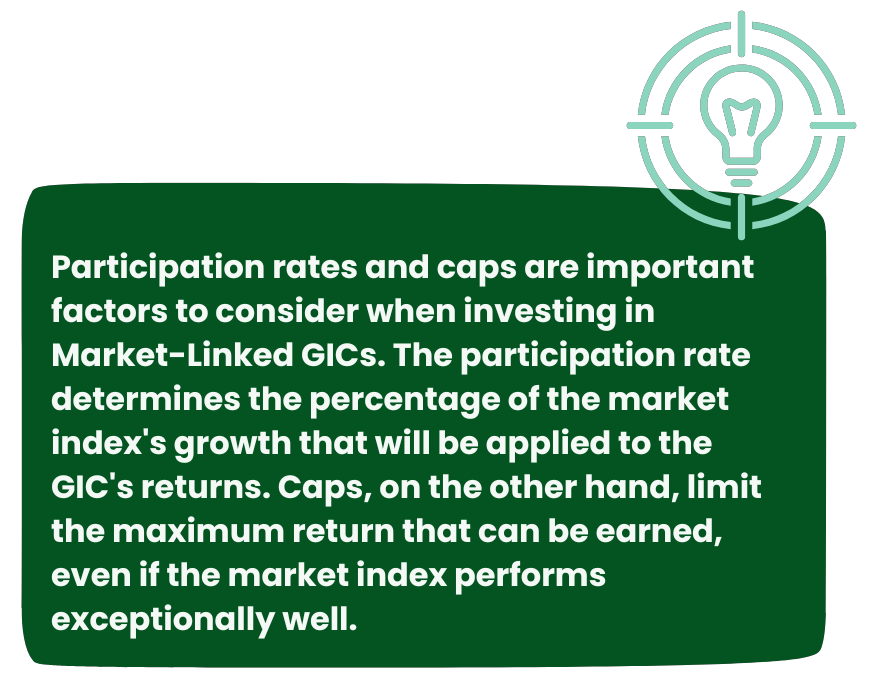
In investing, Canadians have various options to grow their wealth. One such option is Market-Linked Guaranteed Investment Certificates (GICs). This article aims to provide an engaging and comprehensive overview for Canadian investors. We will delve into the basic concepts, benefits, and drawbacks of these investment instruments, helping readers understand their potential as part of a well-rounded investment strategy.
Guaranteed Investment Certificates (GICs)
Before delving into the specifics of market-linked GICs, it is crucial to grasp the fundamental concepts of Guaranteed Investment Certificates (GICs). To help you gain a solid understanding, we have compiled a list of key definitions related to GICs. This list serves as a primer, providing concise explanations of essential terms and concepts that will lay the groundwork for comprehending GICs as a whole. By familiarizing yourself with these definitions, you will be equipped with the necessary knowledge to explore the intricacies of these products with greater clarity and confidence. So let’s dive into the essential definitions that will help you grasp the fundamentals of GICs and set the stage for a deeper exploration of market-linked GICs.

Understanding these key definitions will lay a strong foundation for comprehending GICs before diving into the specifics of market-linked GICs. If you would like more details on traditional GICs before delving into Market-Linked GICs you can find more information in our blog “GIC Investing in Canada 101: A Comprehensive Guide to Guaranteed Investment Certificates“.
How do Market-Linked GICs differ from Traditional GICs?
While both Market-Linked GICs and traditional GICs guarantee the principal amount invested, they differ in terms of potential returns. Traditional GICs offer a fixed interest rate for the entire term, while Market-Linked GICs provide returns based on the performance of an underlying market index.
Comparing Market-Linked GICs with Mutual Funds
Market-Linked GICs and mutual funds are different investment options with distinct characteristics. While Market-Linked GICs offer principal protection and exposure to the stock market, mutual funds provide diversification and professional portfolio management. Consider your risk tolerance, investment goals, and preferences when choosing between the two.
Market-Linked GICs vs. Stocks and Bonds
Market-Linked GICs can be an alternative for investors seeking exposure to the stock market without directly investing in individual stocks. Compared to bonds, Market-Linked GICs offer potential returns that are linked to the market index, whereas bonds provide fixed interest payments.
If you would like to delve deeper into the various types of investments that are available to you as an investor you can find more in our blog “A Comprehensive FAQ Guide: Understanding Investment Types for Canadians“.
Definition and Features
Market-Linked GICs offer a unique investment opportunity that combines the best features of fixed-income investments and stock-like returns. Here’s why they’re worth considering:
- Participate in Stock Market Performance:
- Market-Linked GICs allow you to benefit from the performance of the stock market while safeguarding your initial investment.
- Connected to an Underlying Market Index:
- These GICs are directly linked to a specific market index, such as the S&P/TSX Composite Index, ensuring that your returns are influenced by the index’s performance.
- Potential for Higher Returns:
- With Market-Linked GICs, you can earn interest rates that surpass those offered by traditional GICs.
- Protection of Invested Amount:
- While providing the opportunity for higher returns, Market-Linked GICs also protect your invested funds, ensuring that your principal amount remains intact.
- Diversify Your Portfolio:
- Investing in Market-Linked GICs allows you to diversify your portfolio by gaining exposure to the stock market without assuming the same level of risk as direct stock investments.
- Balanced Blend of Stability and Growth:
- These GICs provide a balanced combination of stability and growth potential, making them suitable for investors seeking a middle ground between fixed-income investments and stock market participation.
Market-Linked GICs offer an enticing opportunity to explore the stock market’s growth potential while maintaining a level of security for your investment. With their potential for higher returns and principal protection, they can be a valuable addition to your investment strategy.
Disadvantages
- Limited Upside Potential:
- While Market-Linked GICs offer the potential for higher returns, they often come with a cap on the maximum return achievable. This limits the upside potential compared to directly investing in the underlying market index.
- Complexity
- Market-Linked GICs can be more complex than traditional GICs, requiring investors to understand the terms, conditions, and calculations involved. It’s crucial to carefully review the product details and consult with a financial advisor if needed.

Considerations before Investing
Assessing Risk and Suitability
Before investing in Market-Linked GICs, it’s essential to assess your risk appetite and investment goals. These products may not be suitable for all investors, especially those seeking guaranteed returns or short-term liquidity.
Risk Appetite and Investment Goals
Your risk appetite and investment goals play a crucial role in determining whether Market-Linked GICs align with your financial objectives. Conservative investors may prefer the stability of traditional GICs, while growth-oriented investors may be attracted to the potential for higher returns offered by Market-Linked GICs.
Considering Time Horizon
The term length of the investment should align with your time horizon. Market-Linked GICs typically have longer terms, often ranging from three to six years. It’s important to evaluate your liquidity needs and investment timeframe before committing to a Market-Linked GIC.
Evaluating Risk-Reward Tradeoff
Investors must evaluate the risk-reward tradeoff of Market-Linked GICs. While they offer the potential for higher returns, they also come with risks, including the possibility of earning lower returns compared to traditional GICs if the market index performs poorly.
Tax Considerations and Potential Penalties Considerations
Understanding the tax implications or potential penalties of Market-Linked GICs is essential for effective financial planning. Consider the following aspects:
- Taxation of Interest Income
- Interest earned from Market-Linked GICs is generally taxed as income if it is held in a non-registered account. The tax rate applied depends on your income tax bracket. Consult a tax professional to understand the specific tax implications based on your situation.
- Implications of Early Withdrawals
- Withdrawing funds from a Market-Linked GIC before the maturity date may result in penalties or reduced returns. Familiarize yourself with the specific terms and conditions related to early withdrawals.
- Registered vs. Non-Registered Accounts
- Consider whether to invest in Market-Linked GICs through registered accounts, such as Tax-Free Savings Accounts (TFSAs) or Registered Retirement Savings Plans (RRSPs). These accounts may offer tax advantages, but contribution limits and other factors should be considered.
Frequently Asked Questions
1. What is the difference between a Market-Linked GIC and a traditional GIC?
Market-Linked GICs differ from traditional GICs in the way their returns are calculated. While traditional GICs offer a fixed interest rate throughout the term, Market-Linked GICs link their returns to the performance of an underlying market index, such as the S&P/TSX Composite Index. This means that the returns of Market-Linked GICs can vary based on how the market index performs.
2. How are the returns of Market-Linked GICs calculated?
The returns of Market-Linked GICs are calculated based on the performance of the underlying market index to which they are linked. If the market index performs well during the term of the GIC, the returns will reflect that positive performance. However, if the market index performs poorly, the returns may be lower compared to traditional GICs or even result in no additional interest earned.
3. Are Market-Linked GICs suitable for all investors?
Market-Linked GICs may not be suitable for all investors. They are typically more suitable for investors who are willing to accept some level of market risk in exchange for the potential of higher returns. Investors who prefer stability and guaranteed returns may find traditional GICs more suitable for their risk tolerance.
4. Can I withdraw my funds from a Market-Linked GIC before the maturity date?
Market-Linked GICs generally have restrictions on withdrawing funds before the maturity date. These restrictions vary depending on the specific terms and conditions of the GIC. Early withdrawals may result in penalties or a loss of potential returns. It is important to carefully review the terms of the Market-Linked GIC to understand the rules regarding early withdrawals.
5. How do I choose the right Market-Linked GIC for my investment portfolio?
Choosing the right Market-Linked GIC involves considering various factors. Here are some key considerations:
- Understand the terms and conditions: Review the details of the Market-Linked GIC, including the participation rate, cap, term length, and any additional features or limitations.
- Assess your risk tolerance: Consider your comfort level with market fluctuations and your investment goals.
- Seek advice if needed: Consult with a financial advisor who can provide personalized guidance based on your financial situation and goals.
- Compare options: Compare Market-Linked GICs offered by different financial institutions to find the one that best aligns with your investment needs and objectives.
Careful evaluation and understanding of the terms and conditions will help you make an informed decision when choosing the right Market-Linked GIC for your investment portfolio.
Conclusion
In conclusion, Market-Linked Guaranteed Investment Certificates (GICs) present a compelling option for Canadian investors looking to grow their wealth. By combining the stability of fixed-income investments with the potential for higher returns similar to stocks, Market-Linked GICs offer a balanced blend of growth and security. Throughout this article, we have explored the fundamental concepts of GICs, providing essential definitions to help readers grasp the basics before diving into the specifics of market-linked GICs.
Understanding the distinction between Market-Linked GICs and traditional GICs is crucial. While traditional GICs provide a fixed interest rate, Market-Linked GICs connect returns to the performance of an underlying market index. We have also compared Market-Linked GICs to other investment options, such as mutual funds, stocks, and bonds, offering insights into their unique features and benefits.
When considering Market-Linked GICs, it is essential to evaluate various factors, including risk tolerance, investment goals, and time horizon. By carefully assessing the risk-reward tradeoff and understanding tax considerations, investors can make informed decisions aligned with their financial objectives.
By delving into the world of Market-Linked GICs, investors gain access to the potential for higher returns while protecting their initial investment. However, it’s important to weigh the advantages and disadvantages, as well as consider individual circumstances and preferences.
As Canadian investors seek opportunities to diversify and maximize their investment potential, Market-Linked GICs serve as a valuable tool to achieve a balanced approach to wealth growth. By leveraging the benefits of market participation and principal protection, Market-Linked GICs can play a significant role in a well-rounded investment strategy.
Remember to consult with financial advisors and utilize reputable resources to make informed decisions and stay updated on evolving market trends. With careful consideration and a comprehensive understanding of Market-Linked GICs, investors can navigate the investment landscape with confidence and strive toward their financial goals.
Additional Resources
Canada.ca – Investment and Saving: The official Government of Canada website provides comprehensive information on investment options, savings plans, and resources for investors.
Canadian Investor Protection Fund (CIPF): The CIPF website offers information on protecting investments held with IIROC-member firms, including coverage limits and investor resources.





